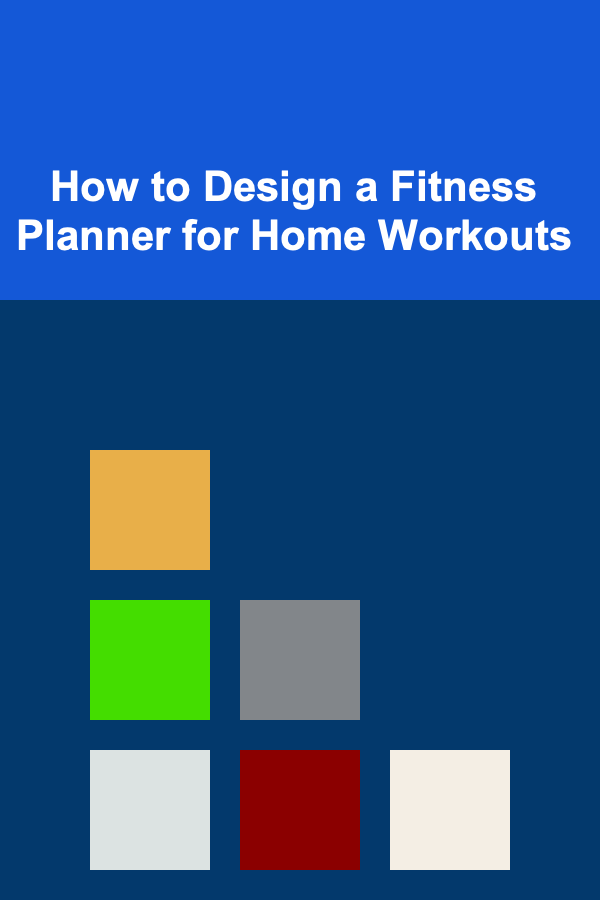
How to Design a Fitness Planner for Home Workouts
ebook include PDF & Audio bundle (Micro Guide)
$12.99$9.99
Limited Time Offer! Order within the next:

In today's fast-paced world, finding time to go to the gym or participate in fitness classes can be a challenge. More people are turning to home workouts as a way to stay fit without the need for expensive memberships or travel time. Designing a fitness planner specifically for home workouts can help individuals create personalized workout routines, track their progress, and stay motivated. This article will provide a comprehensive guide on how to design an effective and efficient fitness planner for home workouts.
Understanding the Basics of a Fitness Planner
A fitness planner serves as a tool to help individuals organize and structure their workout routines. It allows users to plan, track, and review their progress over time. When designing a fitness planner for home workouts, several factors need to be taken into account, including goals, available space, equipment, time, and personal preferences.
Key Elements of a Fitness Planner
-
Personal Information: A section where users can fill out their basic details like age, height, weight, fitness level, and any medical conditions or injuries. This information helps tailor the fitness planner to the individual's needs.
-
Fitness Goals: Defining specific goals is essential for staying focused and motivated. Whether the goal is to lose weight, build muscle, improve flexibility, or enhance overall fitness, the fitness planner should have space for users to record these objectives.
-
Workout Schedule: This section should allow users to plan their workouts on a weekly or monthly basis. It should be flexible enough to accommodate different types of exercises, such as strength training, cardio, yoga, or stretching.
-
Exercise Log: An exercise log is where users can track the exercises they do, the number of sets, reps, and weights (if applicable). This helps users keep track of their progress and adjust their routines over time.
-
Nutrition Tracking: Since fitness and nutrition go hand in hand, the planner should include space to track daily meals, calorie intake, and hydration. This can help users stay on track with their fitness goals.
-
Rest and Recovery: Recovery is a vital part of any fitness program, and the planner should remind users of the importance of rest days, stretching, and sleep. Users can also track their sleep patterns and recovery times.
-
Progress Monitoring: The fitness planner should have sections for users to log their weight, measurements, strength levels, and endurance. Tracking these metrics will allow users to see how they are progressing toward their goals.
Steps to Design a Fitness Planner for Home Workouts
Now that we have an understanding of the basics, let's dive into the steps required to design a fitness planner that suits home workouts.
1. Assessing the Target Audience
Before designing a fitness planner, it is crucial to understand the needs of the target audience. Are you designing it for beginners, intermediate fitness enthusiasts, or advanced athletes? The content, structure, and level of detail should be customized based on the fitness levels of the users.
- Beginners: Focus on simplicity, clear instructions, and easy-to-follow exercises. Include information about proper form and technique.
- Intermediate: Offer more advanced workout routines, with varied exercises and equipment options.
- Advanced: Include challenging workouts, performance tracking, and advanced techniques.
2. Setting Realistic and Achievable Goals
A key aspect of any fitness plan is setting goals. Your planner should help users set both short-term and long-term fitness goals. These goals should be SMART (Specific, Measurable, Achievable, Relevant, and Time-bound).
- Short-term goals could be related to completing a certain number of workouts per week or mastering a specific exercise.
- Long-term goals might involve achieving a particular body fat percentage, lifting a specific weight, or running a certain distance.
The planner should have sections where users can write down their goals, as well as space to periodically check in and assess progress.
3. Choosing the Right Exercises
Home workouts often have limitations in terms of space and equipment. When designing the planner, include a mix of exercises that require minimal or no equipment, such as bodyweight exercises, yoga, and Pilates, as well as exercises that can be performed with household items like resistance bands, dumbbells, or kettlebells.
Examples of Effective Home Workout Exercises:
- Bodyweight Exercises: Push-ups, squats, lunges, planks, mountain climbers.
- Strength Training: Dumbbell presses, rows, kettlebell swings, resistance band exercises.
- Cardio: Jump rope, burpees, high knees, jumping jacks.
- Flexibility and Mobility: Yoga poses, dynamic stretching, foam rolling.
- Core Training: Bicycle crunches, leg raises, Russian twists.
Ensure that there is variety in the exercises to keep users engaged and help them target different muscle groups.
4. Designing a Weekly or Monthly Workout Schedule
The planner should provide flexibility in terms of scheduling. Some users may prefer a daily schedule, while others may opt for a weekly or monthly overview.
Example Weekly Structure:
- Day 1: Full-body strength training (e.g., squats, push-ups, lunges).
- Day 2: Cardio workout (e.g., 30-minute jog, high-intensity interval training).
- Day 3: Yoga or flexibility training (e.g., sun salutations, hip stretches).
- Day 4: Upper-body strength (e.g., dumbbell presses, tricep dips).
- Day 5: Core workout (e.g., planks, bicycle crunches).
- Day 6: Active rest (e.g., light walking, stretching).
- Day 7: Rest day or recovery session (e.g., foam rolling, meditation).
This type of weekly schedule ensures that all fitness components---strength, cardio, flexibility, and rest---are balanced throughout the week. Make sure to leave room for adjustments, allowing users to swap workouts based on their preferences or needs.
5. Including Rest and Recovery Plans
Rest and recovery are often overlooked, but they are essential for muscle repair and injury prevention. In your planner, incorporate a section that emphasizes the importance of recovery, such as:
- Active rest days with low-impact exercises.
- Stretching routines for flexibility and muscle recovery.
- Sleep tracking to ensure users are getting enough rest for optimal performance.
6. Tracking Progress
A fitness planner is not just about planning workouts; it's also about tracking progress. Provide space for users to log various metrics, such as:
- Strength: The number of sets, reps, or weights lifted in exercises.
- Endurance: The time spent doing cardio or the number of repetitions completed.
- Body Measurements: Weight, body fat percentage, waist circumference, etc.
- Nutrition: Daily calorie intake, protein, carbs, fats, and water intake.
Tracking progress helps users stay motivated by seeing their improvements over time. Include periodic checkpoints (e.g., weekly, monthly) where users can review their progress and adjust their goals if needed.
7. Incorporating Motivational Elements
Motivation is a key factor in sticking with a fitness routine, especially when working out at home. To keep users engaged, incorporate motivational elements such as:
- Inspirational Quotes: Include motivational quotes throughout the planner to encourage users on their fitness journey.
- Challenges: Add monthly fitness challenges, such as completing a certain number of push-ups or holding a plank for a longer time.
- Rewards System: Encourage users to reward themselves after reaching specific milestones, such as completing a workout streak or hitting a fitness goal.
Conclusion
Designing a fitness planner for home workouts is about creating a tool that helps individuals structure their fitness journey, stay on track, and achieve their goals. By considering the target audience, offering flexibility, providing a balanced workout schedule, and including tracking and motivational elements, a fitness planner can be an invaluable resource for anyone looking to improve their fitness from the comfort of their home.
By following the steps outlined in this article, you can create a fitness planner that not only organizes workouts but also fosters a sense of accomplishment and motivation, empowering individuals to live healthier, more active lives. Whether the goal is weight loss, muscle gain, or overall wellness, a well-designed fitness planner can make all the difference in achieving success.
Reading More From Our Other Websites
- [Personal Care Tips 101] How to Use Antiperspirant During the Summer Months
- [Survival Kit 101] Best Survival Kit for Beginners: Everything You Need for Outdoor Adventures
- [Organization Tip 101] How to Optimize Under-Bed Storage for Extra Space
- [Home Lighting 101] How to Make a Grand Entrance: Entryway Lighting that Makes a Statement
- [Tie-Dyeing Tip 101] From Freezer to Fabric: The Science Behind Ice Tie-Dyeing and How It Works
- [Organization Tip 101] What Are the Benefits of Using Labels for Home Organization?
- [Home Budget Decorating 101] How to Style Your Home for the Holidays Without Overspending
- [Stamp Making Tip 101] Transforming Everyday Erasers into Personalized Stamps
- [Home Soundproofing 101] How to Manage Noise from Neighbors in a Shared Building
- [Ziplining Tip 101] Post‑Production Magic: Editing Techniques to Turn Zipline Footage into Thrilling Content

How to Use Color-Coding to Organize Your Luxury Wardrobe
Read More
How to Use Vertical Space for Laundry Storage
Read More
Why Seasonal Decluttering is Important for Space
Read More
Discovering the Benefits of Dry Brushing: A Comprehensive Guide
Read More
How to Analyze a Company's Financial Statements Like a Pro
Read More10 Tips to Automate Your Cash Flow Projection Tracker
Read MoreOther Products

How to Use Color-Coding to Organize Your Luxury Wardrobe
Read More
How to Use Vertical Space for Laundry Storage
Read More
Why Seasonal Decluttering is Important for Space
Read More
Discovering the Benefits of Dry Brushing: A Comprehensive Guide
Read More